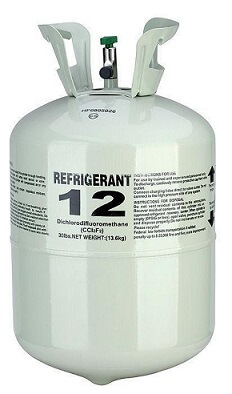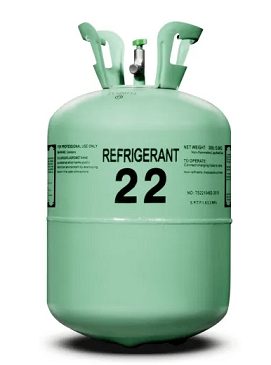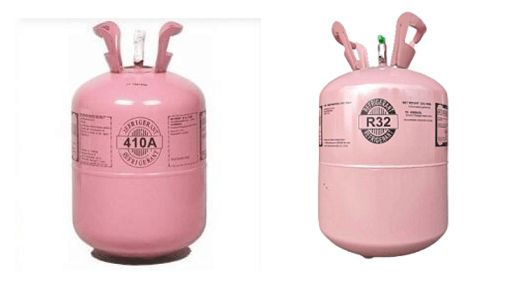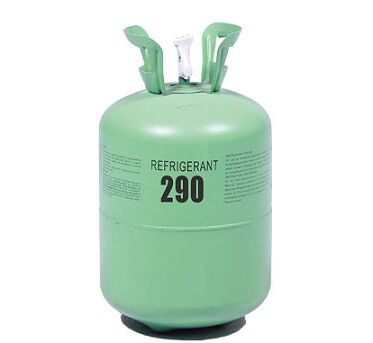“Which type of refrigerant does your AC use?”
Did you know that a refrigerant gives your air conditioner the power to cool? Yes. Without a refrigerant, there is no air conditioning technology.
If you are planning to buy a new air conditioning unit, it is advisable to look for the type of refrigerant the unit has. Also, if you are thinking of replacing the coolant you should identify which type of gas your AC has.
But before doing any of the above, you should have a clear understanding of the different types of refrigerants available for air conditioners.
Not all refrigerants are environmental-friendly. Some of them pose a serious threat to the environment, significantly contributing to global warming.
In this article, we bring you various types of refrigerants and their uses. Continue reading below to know which gas your AC uses.
What is a Refrigerant?

A refrigerant works under the basic principle of thermodynamics, i.e., changes from liquid to gas and vice versa during the refrigerant cycle.
The ideal refrigerant for any air conditioner or cooling appliance should have some prerequisites like non-corrosive nature, inflammable and non-toxic.
Most importantly, it must have zero potential for global warming, climate change, and, above all, ozone depletion.
How Does A Refrigerant Work?
Do you want to learn how a refrigerant works or how it helps your refrigerator and air conditioner? Here is how it does:
- During the refrigeration cycle, the refrigerant first passes through the expansion device of the unit as a high-pressure liquid. While passing it undergoes a pressure drop, which makes the liquid cool down to a low-pressure liquid.
- The low-pressure liquid now passes through the evaporator coils inside the unit.
- When passing through the coils, it absorbs the heat and evaporates into a low-pressure gas.
- This refrigerant gas circulates through the compressor and gets compressed into a high-pressure gas.
- Now, this high-pressure gas passes through the condenser coils and cools back into a high-pressure liquid.
- The liquid refrigerant, back to its initial state, re-enters the expansion device to begin the process all over again.
Which are the Refrigerants/Gas used in AC?
Below is a list of refrigerants used by most air conditioner manufacturers across the world:
1. Chlorofluorocarbons or R12

2. Hydrochlorofluorocarbons or R22

Being inflammable and non-toxic, R-22 was an ideal refrigerant for an air conditioner. However, this also got phased out because of its ozone-depleting nature. The presence of chlorine in this refrigerant poses a threat to the ozone layer and the environment.
3. Hydrofluorocarbons (R-410A and R-32)

The other merit to HFCs is that they have zero potential for ozone depletion and are hence, considered a replacement to other refrigerants. R-410A and R-32 are the most commonly used HFCs in air conditioners that are better in terms of energy efficiency too.
R-410A is a combination of two other HFC refrigerants, namely, R-125 and R-32. In comparison to other HCFC refrigerants, R-410 offers greater cooling properties when subjected to higher pressures. Moreover, it does not carry any potential to harm the ozone layer, becoming the widespread option for many manufacturers.
Till 2018, about 20% to 30% of air conditioners in India used HFCs.
4. HCs or Hydrocarbons
In recent times, Hydrocarbons or HCs are the refrigerants that gained wider acceptance all over the world. Many air conditioner and refrigerator manufacturers started using the HCs in their systems. R-290 and R-600A are the most common hydrocarbon refrigerants used.
Propane is the chemical name for R-290, and Iso-Butane is the chemical name for R-600A.
Both R-290 and R-600A have zero potential for ozone depletion. Not only that, but they also have a low global warming potential and are halogen-free. Although Hydrocarbons possess high energy efficiency, they are highly flammable, too. Many manufacturers who use HC as refrigerants claim that they are safe. However, one needs to be diligent when using it in the AC.
Below is a table illustrating the Global warming and Ozone depletion potential of various refrigerants.
R-290 as a refrigerant achieved approval for air conditioning applications by both national and international safety authorities. Despite being highly flammable, R290 got the safety confirmation from safety standards because of the low flammability risk in case of any leakage. Switching to R-290 in air conditioners will not only benefit the environment but will also help you save money in the future. These refrigerants are highly suitable in a country like India with high ambient temperature. No, the AC gas or refrigerant does not need any replaced unless there are any leaks. In such a case, you can efficiently tackle this issue by calling a technician who can fix what went wrong in the system. However, gas leakage does not always happen. It is a rare scenario that occurs and which you can realize only after you start using the device again. The technician can help you deal with this by refilling the refrigerant or even replacing the refrigerant component if needed. To help users identify the type of refrigerant used in the air conditioners, manufacturers use a large sticker or plate posted on the compressor or the condenser. This contains what type of coolant that particular unit uses, which could be either R-410A, R22, Freon, or similar types. Ever since hydrofluorocarbons (HFCs) entered the market, hydrochlorofluorocarbons (HCFCs) got phased out. They became a potential alternative for HCFCs that contain chlorine and have a high ODP when compared to HFCs. In any case, if you want to replace your cooling agent, you should be aware of which type of refrigerant your AC is using. The refrigerants are not interchangeable. Some possible differences can help you distinguish and determine between the types of refrigerants. ACs that use HFCs generate more noise and need to operate at high pressures. Not only that, you should use synthetic oil in the compressor along with a refrigerant. When it comes to ACs using HCFCs, they are less noisy and operate at average or low pressures. They use mineral oil along with the coolant, which is highly soluble. Considering these differences, always prefer a refrigerant for a replacement that is compatible with your system. Any negligence can damage or destroy your AC unit, altogether. Seek the help of an experienced technician before you plan for replacing or switching your refrigerant. A technician is the right person who can assist you in the safe disposal of the coolants. When mishandled, the refrigerant can be dangerous to the environment and humans. Hence, consider purchasing one from a licensed technician. Earlier, air conditioners used HCFCs and HFCs. These are in use even today. R-22 and R-410 and R-32 are the commonly used HCFCs and HFCs, respectively. Most newer AC units use R-410 and Puron these days. With the advent of environment-friendly refrigerants, like R-290 and R-600A, HC refrigerants pave the way for wider adoption. Considering the impact that a refrigerant has on the environment, a refrigerant should comply with the regulations. R-290 and R-600A are refrigerants that are viable replacements for older coolants and also, have a negligible effect on global warming, and zero effect on ozone depletion. Even if the type of refrigerant that your AC uses got banned, there are still chances of them being available for purchase. However, it would be better to upgrade your AC instead of using the phased-out gas. If you decide to replace your AC entirely with a new, highly efficient model, you will not have to worry about anything as such. You will not run short of refrigerant, and you will be contributing to environmental safety in the future. Above all, you can enjoy the valuable benefits of energy efficiency and reliability of the newer unit. Which type of refrigerant does your AC use? I hope this article answered your question that many users are unaware of and often tend to neglect. If you are still unsure about which type of refrigerant your air conditioner uses, seek professional help. It becomes our responsibility to protect and safeguard our environment by reducing global warming and eliminating ozone layer depletion. If you want to join your hands in achieving this endeavour, switch to an eco-friendly refrigerant. If you are planning to buy an AC unit, ensure you opt for an environmental-friendly and energy-efficient model. If you have any questions or need more information about AC refrigerants, write to us in the comments section below. We will answer all your queries as soon as possible. Go green, stay safe!Which is the Most Energy-Efficient AC Refrigerant?

Do you Have to Replace your AC gas/refrigerant?
How To Tell What Type Of Home AC Refrigerant My Unit Takes?
What Type Of Refrigerant Does Your Unit Use Now?
What To Do If Your Refrigerant Type Is Banned?
Conclusion:

